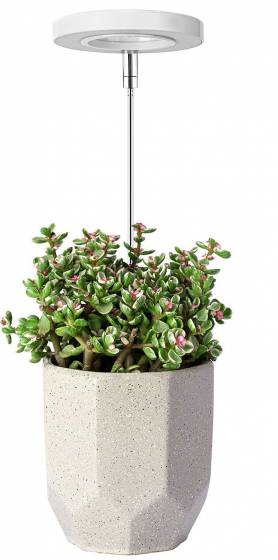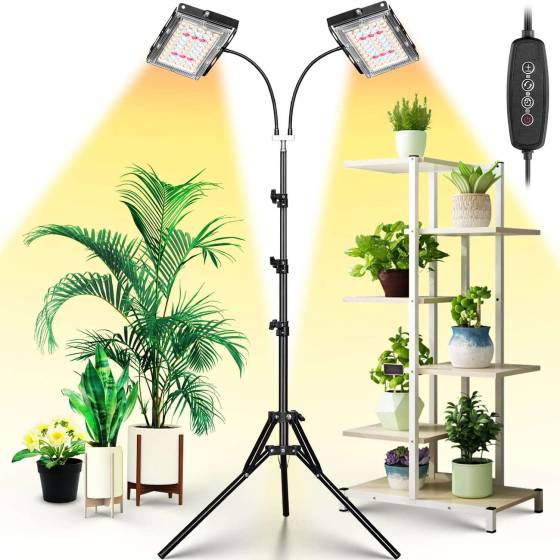Plants are a great addition to any room. They look nice, they make the air fresher, and they can help to improve your mood too.
That last point is such a trope that in classic video games such as Theme Hospital, adding a plant to one of the offices would boost the happiness of anyone in that office!
So can you grow plants with a desk lamp? Yes! The challenge, though, is that plants need specific light to thrive. This is a guide that will give you all the necessary information.
Looney lumens is reader-supported and participates in the Amazon Associates Program. When you buy a product through links on our site, we may earn a small commission, at no extra cost to you.
For those that are in a hurry and looking to buy a good growing lamp we suggest checking out our top pick below:
OUR TOP PICK
Hydroponics Indoor Garden by iDOO

iDoo all-in-one is our choice and the top pick for simple hassle-free indoor gardening. This is a hydroponic system, so you grow the plants in the sponges provided, without any soil mess – perfect for growing your herbs in the kitchen or living room. With integrated lights, water, a fan, and an automated timer, growing plants indoors is easy even if you are a beginner gardener.
Growing Plants Using Artificial Light
It is possible to grow houseplants indoors. However, you will need a special kind of light to do so.
You can make a plant grow by using a desk grow lamp but a standard incandescent bulb or an energy-saving light bulb probably won’t do the job.
Sunlight contains the right balance of light wavelengths to make plants bloom. Artificial light usually doesn’t have the same spectrum of light waves in it.
For a plant to thrive, it needs:
Blue light for foliage growth
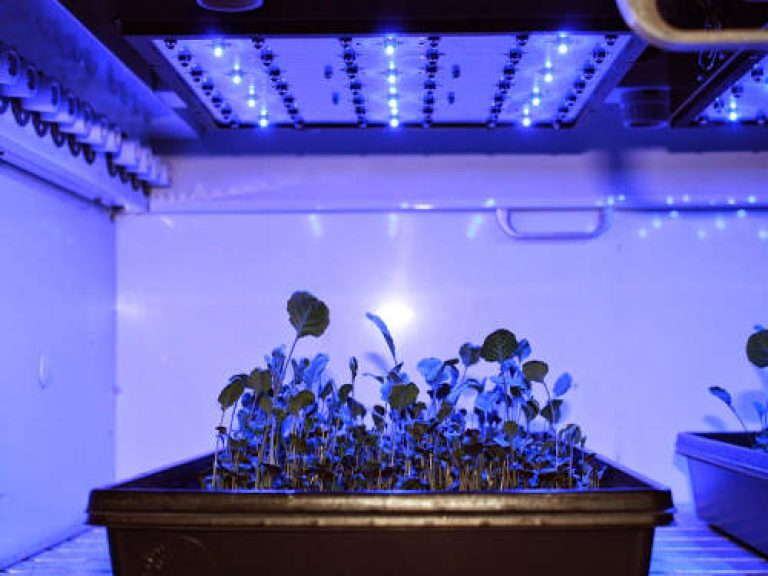
Red light to make it flower
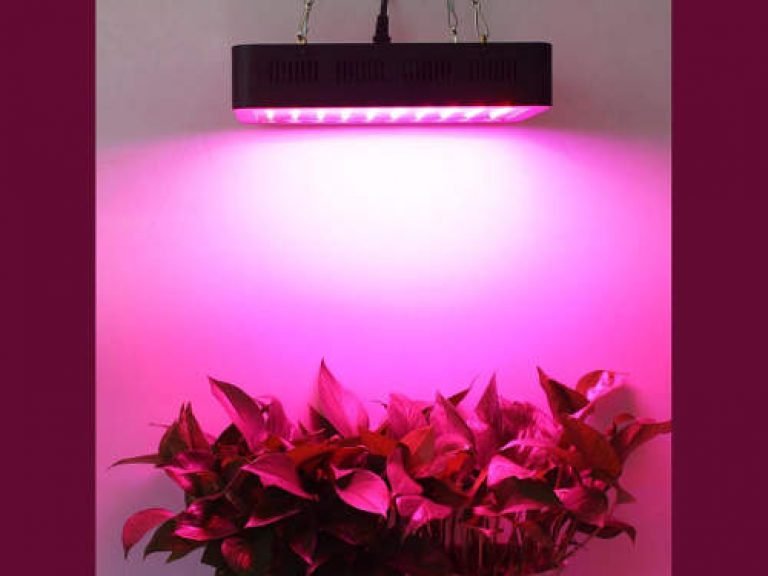
The light that does not get absorbed will get reflected. Indeed, it is the green wavelength being reflected that makes the leaves appear to be green to our eyes.
Common questions
We are going to answer some of the more frequently asked questions about grow lights:
Can a regular light bulb help plants grow?
Yes, you can grow a plant with them, but it’s not the best idea. Their spectrum is concentrated on warm (orange) light, so it is not ideal for foliage growth, which requires more cool (blue-ish) light.
Can you use a grow light bulb in a regular lamp?
Yes. If the regular lamp has the correct socket type and wattage capacity, a grow light bulb should fit into a regular lamp without any problems.
Is natural light or artificial light better for plants?
Nature light is always better for plants because it has a more complete spectrum than any artificial light.
Ideally, an indoor plant should still have some exposure to natural light. Artificial light should be treated as a supplement rather than an alternative. If you are growing plants indoors, it is better to have them next to the window during the day.
The Different Types of Grow Light Bulbs
Today many different kinds of light bulbs exist so let’s take a look at the common ones:
Fluorescent Bulbs

If you want to grow houseplants then fluorescent bulbs are a good option.
They are quite affordable, and they tend not to get too hot when they are in use, either, so they can be placed fairly close to the plant. These bulbs have a long life of about 20,000 hrs and, as such, has been the popular growth light source for a long time.
Choose the tube or a bulb carefully, though. Standard tubes produce light that skews towards the blue wavelength, and that’s not what you really want.
Ideally, you should look for a full-spectrum fluorescent tube that will include cool and warm light colors.
If you’re not sure what tube to choose, pick one that is marketed as ‘cool white’ because white light will include the full spectrum. Keep the tube about a foot away from your plant’s foliage for best results.
Incandescent Bulbs
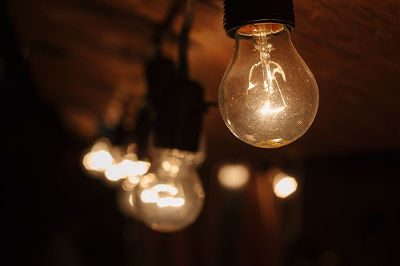
Regular incandescent bulbs get quite warm, and they aren’t all that energy efficient. They give off more red wavelength light than white. They only last about 1,000 hrs.
A regular light bulb can produce the necessary spectrum for plant growth. It needs to be carefully chosen to have the best effect.
It is getting hard to find these bulbs in some parts of the world because they are being phased out in favor of more energy-efficient bulbs.
They burn a lot of energy, and the filaments blow more quickly than most other types. Look for something more energy efficient if you can.
LED Bulbs

LEDs are a good choice for a grow light bulb because you can get them in almost any color.
Good quality LED has a complete spectrum and doesn’t produce much heat and waste energy. It has a super long life of 50,000 hours; therefore, it is ideal for growing plants. Although the LED cost can be much higher than other light sources, so the initial investment is higher.
If you don’t like the color of the light that is produced by those, then you could look for more neutral LED lights as long as they have the right spectrum included.
The good things about LED lights are that they do not tend to get hot and they are incredibly long-lasting and energy efficient.
They can be more expensive to buy upfront than other varieties, but they should last for years and they generally provide the best light for growing plants indoors.
Halogen Bulbs

Similar to incandescent light, halogen light has a sunlight-like spectrum and is more energy-efficient than incandescent light.
It lasts up to 4,000 hours, but still generates considerable heat and concentrates more on the warm light spectrum. It is not ideal for all growth stages.
Horticultural Bulbs

Specialized horticultural lights are the most advanced light source for growing plants.
They usually come with a particular light spectrum, like a red light for flower growth or blue light to grow leaves. They are professional products for large farms that aim for high yields and performance but can be expensive.
If you are only looking for small scale indoor gardening as a hobby, it is unnecessary to use professional horticultural light.
How much light do plants need to grow indoors?
Lux level
The quantity of light is measured by the unit ‘lux’.
One lux is defined as the light from one candle at one-meter distance spread over 1 square meter.
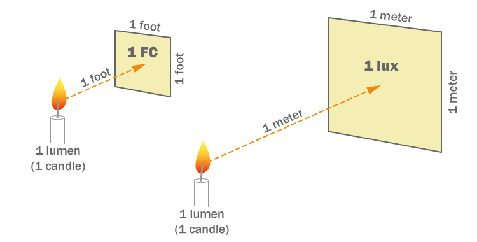
Plants have different light requirements. Sun-loving plants usually need at least 25,000 to 50,000 lux to do well, while shade-loving plants need only 2,500–10,000lux.
Direct sunlight is approximately 100,000 lux, and indirect sunlight gives approximately 20,000lux. An overcast sky gives approximately 2,000lux.
Compared to natural light, the home light source produces much less light(up to 5,000lux). Therefore, many indoor plants still need to be placed near the window to have their daylight and augmented with artificial light for maximum growth.
Below is a table of how much light is required for each plant type and how they can be grown at home with artificial light:
| PLANT TYPE | TYPICAL PLANT | LIGHT REQUIREMENT | INDOOR GROWING METHOD INDOORS |
|---|---|---|---|
| Direct sunlight plants | Aloe Vera, Jade plant, Sago palm, African milk bush | 20,000–50,000 lux | Near South/west facing windows, or near east/north windows and supplemented with artificial light |
| Bright indirect light plants | Bromeliad, English Ivy, Dracaena, Maidenhair Fern | 10,000–20,000 lux | Near East/north windows and supplemented with artificial light |
| Low light plants | Dumb Cane, Parlor Palm | 2,500–10,000 lux | Near East/north windows or under artificial light |
| Deep shade | Cast iron plant, Snake plant and Chinese evergreen | 500–2,500 lux | Away from windows(in a windowed room), or under artificial light |
Hours of light
Different plants also need different hours of light exposure.
Plants can be categorized into a few different types:
- Long-Day
- Short-Day
- Day-neutral
Long-day plants require 14 to 18 hours of light; if they don’t receive enough, they get pale and leggy.
Short-day plants, such as chrysanthemums, kalanchoe, azaleas, and begonias, need less than 12 hours of light per day.
Day-neutral plants, including foliage plants, geraniums, coleus, and African violets can usually thrive with 8 to 12 hours of light all year round.
Usually, the plant’s foliage will tell you whether they are receiving enough light.
A mid-green color to the foliage indicates the plants are receiving the correct amount of light. In contrast, a bleached appearance, yellow-green foliage, or stunted growth means there is too much light. When the foliage becomes a dark green, it means too little light is received.
Plants need light to grow, but they also need some darkness.
While it’s dark, the plants will respirate, and this is just as important a part of the growing process. If they don’t get rest, then they will not thrive properly.
| PLANT TYPE | HOURS OF LIGHT | EXAMPLES |
|---|---|---|
| Long-day plants | 14-18 hours | Vegetable seedlings, garden flowers, cacti, hybrids |
| Day-neutral plants | ~12 hours | Foliage plants (ex. ferns, hostas), geraniums, coleus, African violets |
| Short-day plants | 12 hours or less | Chrysanthemums, kalanchoe, azaleas, begonias |
If you want to grow plants using a desk lamp then it is important that you pay attention to this lighting issue.
You cannot simply buy a plant and change your bulbs, then forget about it.
Think about light as being another form of food, because that’s exactly what it is to a plant. We eat, they photosynthesize – and photosynthesis uses light.
It’s a good idea to invest in a timer for your lamp so that it will be turned on and off to the right schedule.
This may mean that you have the light on even when you’re not using the room, but don’t worry too much about that. Desk lamps, especially LED ones, do not use very much energy at all.

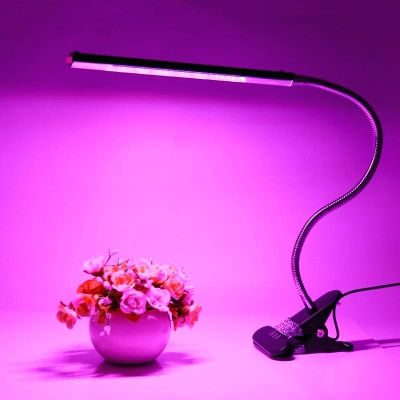
If you really want the ultimate in convenience, there are ‘smart garden’ tools that you can get, including pots with a lamp above them and a reservoir with a mister.
These will keep the plants watered for you at the right rate, as long as you remember to refill the reservoir.
How reliable this is will depend on how humid/warm your rooms are and the plant that you choose. There’s still no substitute for human knowledge when it comes to tending your plants!
Light Spectrum And Color Temperature
Plants primarily use blue and red light for growth, but research has shown some species perform best under the full spectrum that is similar to sunlight.
While natural light varies in color temperature throughout the day, artificial light has a static color temperature. If you want to promote a particular growth stage, it is recommended to choose a full spectrum light with a specific color temperature.
The general rule is to choose a full spectrum grow light with a color temperature in the blue range (5,000 – 7,000K) that will promote vegetative growth.
To promote fruiting and flowering, choose a color temperature in the red spectrum (3,500 – 4,500K).
The correct position of the light source
Keep the right distance!
To grow plants at home, it is better to use lamps with adjustable arms so that you can move the light source away from the plants as they grow taller.
It is recommended to keep the light source at least 3″ away from the top of the plant if you are using an LED or fluorescent lamp and 6″ or more for incandescent or halogen lights. Keeping a light too close runs the risk that the plant is ‘burnt’ by the heat from the light source.
An excellent way to test is to put your hand above the plant under the light – you should not feel warmer than under the sunlight.
Another important aspect is to keep the right light intensity.
The light source also needs to be at the right height so that the right amount of lux level is achieved on the foliage. There are a few lux meter apps available for mobile phones.
More serious growers can invest in a lux meter to get an accurate lux level reading above the plant. Most importantly, the light intensity needs to be consistent. Also, make sure to purchase a broad beam light to cover the whole planting area.
What Plants Will Grow Indoors?
Most plants can grow indoors if you get the right bulb for your lamp.
Grow lights can help to start seeds so that you can plant them outside once they are stronger seedlings.
You can grow herbs indoors so that you can enjoy a fresh harvest even in the winter, and you can get thriving, vibrant houseplants with the right spectrum of light too.


Choose Low Maintenance House Plants
If you are someone who doesn’t know a lot about gardening, or someone who is rarely at home, then you should choose a plant that is fairly low maintenance.
Aloe, Spider Plants, Snake Plant, and Lavender all fit the bill in terms of not needing a lot of specialist care.
Spider plants, however, grow very quickly and you may end up needing to re-pot them or end up with offshoots that you can give away to your friends and family.
Once you get the hang of those ‘easy’ plants you can start looking at others that neeFeaturedd a bit more care.
Remember that even supposedly ‘hard to kill’ plants such as cacti can still wither if they aren’t looked after properly.
Make sure that they get the right amount of light and the right amount of water.
Many people over-water cacti or forget that it is possible for a succulent to become damaged from too much sun exposure.
So, don’t put your cactus on a windowsill, and if you’re exposing it to a desk lamp instead, make sure that the light isn’t too harsh or too close to it so that the leaves don’t get damaged.
Products: All In One Indoor Gardens
What will get you started growing plants indoors with almost no effort is a convenient all-in-one indoor garden system. These are planters integrated with LED grow lights and a watering system and often add other convenient features.
All-in-one indoor gardens are perfect for growing smaller plants, such as herbs in your kitchen, or creating a small decorative planter in your living room.
Hydroponics Indoor Garden Growing System 12 Pods with LED Grow Light by iDOO
iDoo all-in-one is our choice and the top pick for simple hassle-free indoor gardening.
You can grow up to 12 plants at the same time with 12 pods available. This is a hydroponic system, so instead of soil you grow the plants in the sponges provided – this is more efficient and creates no mess – perfect for growing your herbs in the kitchen or living room.
The planter has a 1-gallon (4-litre) water tank with a pump to circulate the water and a visual water level check window.
The 22W LED light has two light modes, one for flowers and one for growing vegetables. The light is height adjustable up to 11″ to fit perfectly both smaller and taller plants.
A small fan in the middle of the lamp helps with airflow to balance the temperature amongst the pods and helps with plant pollination.
Pros
- Great all-in-one combo
- Unique hydroponic growing – no mess
- Beginner friendly
- Well-spaced growing pods
Cons
- Original replacement sponges and baskets are relatively costly (check the price in iDoo store)
All In One Indoor Garden System By Mindful Design
If the Idoo system above is too large, or you are just starting out growing plants indoors, this is a more compact and affordable mini-garden system.
The all-in-one combo of a lamp and planter is complete with a white LED light and low water alert system. It is perfect if you want a nice-looking small patch of indoor green with minimal maintenance.
The lamp produces 4000K full-spectrum white light similar to natural daylight. It can substitute the lack of daylight for indoor plants.
It is an easy-to-maintain system with an automatic 16 hrs on 8 hrs off timer. It also alerts you if the water is too low. Once set up, all you need to do is keep an eye on the water levels.
The white light and the product’s compact design fits great into any home environment. The product would look particularly great in the living room or kitchen.
It is a relatively small plant pot. The product’s main compartment has limited growing space for plants, so only small plants, like herbs and certain flowers, can fit into the system.
Nonetheless, it is still a great starting kit for everyone who wants to start growing plants indoors.
Pros
- Produces similar natural daylight
- Automatic timer
- Water level alerts
- Looks great in any room
Cons
- Small plant pot
- Limited dimming settings
- Limited customization options
Products: Portable Grow Lights
If you already have your plants potted, you can simply add some extra light by using a portable grow light. Following are a few of our picks, going from smaller single-pot lights to more serious larger lights for multi-pot shelves and racks.
Full Spectrum LED Height Adjustable Growing Lamp by LORDEM
Here is a neat solution for just a single pot. Not only the light helps your plant grow, but with its sleek design, it also makes for an elegant plant decoration.
The LED ring light emits full spectrum light just as sunlight, has 50 000 hrs lifetime and comes with an auto on/off timer with three different time settings.
The light is mounted on a simple extendable spike that is height adjustable from 8 to 26″. Just stick the light into the pot, set the timer and you are ready to grow.
Pros
- Ideal for Small Plants
- Very affordable option
Cons
- The power cord is attached to the top light, which hinders the sleek look of the light
Dual-head Grow Light by GHodec
Our next pick is still a small-size grow light, best for just a couple of plant pots. The GHodec lights come as a double-head clip-on light on a 15″ adjustable flexible gooseneck.
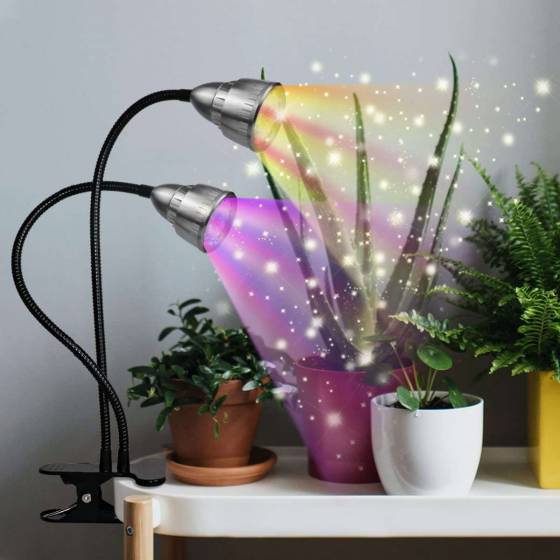
Each head has 6 red, 6 blue, and 10 white LEDs for different stages of your plant growth. The lights are dimmable and have a 30 000 hrs lifespan. The power cord with built-in auto on/off timer comes with a power adapter included.
Pros
- Double-head light
- Adjustable gooseneck
- Clip for easy attachment to shelf or table
- Very affordable
- Power adapter included
Cons
- The timer can be imprecise, shifting the on/off over the time
2. GooingTop LED Grow Light
Now our next pick is very similar in function to the smaller GHodec dual-head light above. The main difference is GooingTop lights come with a 12V 3A adapter, meaning more power to drive more LEDs – 168 of them, to be specific.

Larger light output and longer 8″-10″ light heads allow for more pots on each side of your grow lamp. The lamp comes in two variations, 50W and 100W incandescent bulb equivalent, but thanks to energy-efficient LEDs consumes only 18 or 36W.
Other features are on-par with the rest: strong clip for up to 3″ thick shelf, 15″ adjustable gooseneck, adjustable brightness, and auto on/off timer with three settings.
Pros
- Clip-on flexible gooseneck
- Dimming and timer
- Timer and memory function
- Perfect for succulents
Cons
- More light means higher energy consumption that USB powered lights
- Cannot choose just blue/red light
Multi-Head Grow Light with Tripod Stand by LBW
While not strictly a table lamp, our final pick is for people getting serious about growing their plants indoors. If you have a taller shelf rack full of plants in need of some extra light to support their growth, the LBW tripod light might be your perfect solution.
While we are featuring here the dual-head version with the timer, you can also buy a single, double or triple-head version depending on your needs.
For the dual-head version: Each light head has 50 LEDs, 6 red, 30 warm white (3500K), and 14 cold white (6000K), producing a perfect mix of light for indoor plants.
While the dual head outputs the equivalent of 2x100W incandescent light (4500 lm), they are 2x20W power-efficient LED lights with a 50 000 hr lifespan.
The light heads can be automatically turned on/off via a convenient timer, and are dimmable with 6 brightness settings.
The stand height is adjustable from 21 to 67 inches (50 to 170 cm) to brighten even the taller plant racks.
Pros
- Tall height-adjustable tripod
- Powerful LEDs with a 50000 hr lifespan
- Dimmable with auto timer
Cons
- When fully extended, the tripod is top-heavy and less stable
Questions To Ask Before Buying A Plant-Growing Lamp
- What size plants do you intend to grow? Are you growing small herbs or medium size pots?
- Where will your plants grow? Do you grow plants outdoors in areas with limited sunlight (north-facing or shadowed by buildings) or they are indoors with little daylight?
- What is the purpose of the plant light? Do you want to supplement daylight or use a particular light to promote seeding or flowering?
- How much adjustability and dimming control will be needed?
- How much maintenance do you want to take on?
- How would the light complement your home? Would you accept red/blue light or would plain white light be preferable?
FINAL THOUGHTS
A simple compact system would be a great choice for someone who wants a pretty fresh herbs pot without much effort.
For more committed gardeners, an adjustable white light plant light is good for plant growth in places with insufficient daylight.
If your plants have access to daylight but could use some extra help to maximize growth, the blue and red light would be a wonderful ‘light supplement’.
Whether the plants need additional daylight or a particular spectrum is an essential question. Besides, the more adjustability a product has, the more control you have, but you might not need that much.
If you love doing DIY projects then you can create your very own desk lamp by following our simple guide!
External sources
- https://www.backyardboss.net/lights-for-growing-plants-indoors/
- https://www.rhs.org.uk/advice/profile?PID=1033&awc=2273_1594469658_3d3d55fb23446ed974afda8451930c97
- https://www.proflowers.com/blog/plants-that-dont-need-sun
- https://www.thespruce.com/best-houseplants-for-sun-4147670
Other Useful Links
Author: Ting Ji

Ting is an independent lighting designer living and working in London with 8+ years of experience. She has successfully delivered various master plans, landscape, and interior projects all over the world. Ting also worked on a diverse range of projects in urban, heritage, multi-use, workspace, retail, hospitality, and daylight. LinkedIn profile.


